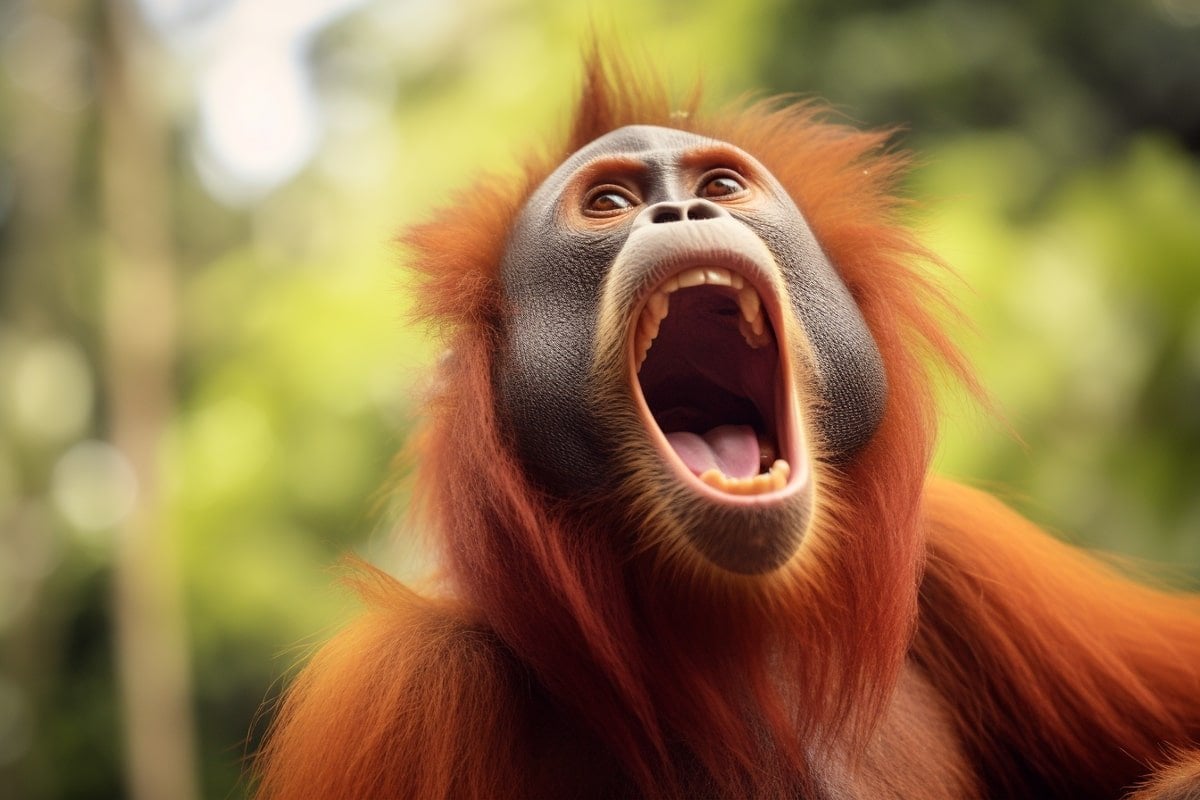Summary: Orangutans are capable of simultaneously producing two different sounds, akin to human beatboxers or songbirds. Through observations of vocalising orangutan populations in Borneo and Sumatra, researchers discovered this shared vocal phenomenon.
The findings raise interesting questions about the evolution of human speech and beatboxing capabilities. The researchers argue that the ability to produce dual sounds could be part of the early language structure of our ancestors.
Key Facts:
- Orangutans in Borneo and Sumatra were observed producing two different sounds simultaneously, like human beatboxers or songbirds.
- The vocal phenomenon discovered suggests that our ancestors’ early language structure might have resembled something like beatboxing.
- The study implies that the vocal control abilities of great apes, a shared ancestor, have been underestimated compared to the focus on bird vocal abilities.
Source: University of Warwick
Orangutans can make two separate sounds simultaneously, much like songbirds or human beatboxers, according to a study led by the University of Warwick.
Academics say the findings provide clues around the evolution of human speech, as well as human beatboxing.
Scientists observed two populations of vocalizing orangutans in Borneo and Sumatra across a total of 3800 hours and found primates within both groups used the same vocal phenomenon.

Dr Adriano Lameira, Associate Professor of Psychology at the University of Warwick said: “Humans use the lips, tongue, and jaw to make the unvoiced sounds of consonants, while activating the vocal folds in the larynx with exhaled air to make the voiced, open sounds of vowels.
“Orangutans are also capable of producing both types of sounds—and both at once.
“For example, large male orangutans in Borneo will produce noises known as “chomps” in combination with “grumbles” in combative situations. Female orangutans in Sumatra produce “kiss squeaks” at the same time as “rolling calls” to alert others of a possible predator threat.
“The fact that two separate populations of orangutans were observed making two calls simultaneously, is proof that this is a biological phenomenon.”
Co-author and independent researcher Madeleine Hardus added: “Humans rarely produce voiced and voiceless noises simultaneously. The exception is beatboxing, a skilled vocal performance which mimicks the complex beats of hip hop music.
“But the very fact that humans are anatomically able to beatbox, raises questions about where that ability came from. We know now the answer could lie within the evolution of our ancestors.”
According to the authors, the vocal control and coordination abilities of wild great apes have been underestimated compared to the focus on the vocal abilities of birds.
“Producing two sounds, exactly how birds produce song, resembles spoken language but bird anatomy has no similarity to our own so it is difficult to make links between birdsong, and spoken human language,” continued Dr Hardus.
The new research has implications for the vocal capabilities of our shared ancestors and for the evolution of human speech—as well as human beatboxing. Dr Lameira said: “Now that we know this vocal ability is part of the great ape repertoire, we can’t ignore the evolutionary links.
“It could be possible that early human language resembled something that sounded more like beatboxing, before evolution organized language into the consonant – vowel structure that we know today.”
About this speech and evolutionary neuroscience research news
Author: Natalie Gidley
Source: University of Warwick
Contact: Natalie Gidley – University of Warwick
Image: The image is credited to Neuroscience News
Original Research: Open access.
“Wild orangutans can simultaneously use two independent vocal sound sources similarly to songbirds and human beatboxers” by Adriano Lameira et al. PNAS Nexus
Abstract
Wild orangutans can simultaneously use two independent vocal sound sources similarly to songbirds and human beatboxers
Speech is among the most complex motoric tasks humans ever perform. Songbirds match this achievement during song production through the precise and simultaneous motor control of two sound sources in the syrinx.
Integrated and intricate motor control has made songbirds comparative models par excellence for the evolution of speech, however, phylogenetic distance with humans prevents an improved understanding of the precursors that, within the human lineage, drove the emergence of advanced vocal motor control and speech.
Here, we report two types of biphonic call combination in wild orangutans that articulatorily resemble human beatboxing and that result from the simultaneous exercise of two vocal sound sources: one unvoiced source achieved through articulatory maneuvering of the lips, tongue, and jaw as typically used for consonant-like call production, plus one voiced source achieved through laryngeal action and voice activation as typically used for vowel-like call production.
Orangutan biphonic call combinations showcase unappreciated levels of, and distinct neuromotor channels for, vocal motor control in a wild great ape, providing a direct vocal motor analogy with birdsong based on the precise and simultaneous co-control of two sound sources.
Findings suggest that speech and human vocal fluency likely built upon complex call combination, coordination and coarticulation capacities that involved vowel-like and consonant-like calls in an ancestral hominid.






